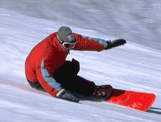

|
Fitness Article
of the Month This months
article focuses on how to choose athletic shoes. It does make a
difference! Credit goes to D.R. Martin. Athletic
Shoes: Finding a Good Match When you walk into an athletic-shoe store, chances are you'll be overwhelmed by the selection and feel the marketing magnet of sports celebrities and their namesake shoes. Superstores may carry hundreds of different joggers from a dozen major brands. And the same goes for most other types of athletic shoes, from walkers and cross-trainers to basketball shoes and football cleats. When seeking the best match between your feet and your sport, you face a decision right away. You can either shop at an athletic-shoe store where employees have special training, or you can spend a few minutes getting to know your feet and your sport or activity before you shop. Finding the Right Shoe Just as human feet vary, so do sports and fitness levels. For example, if you only jog a little every week and play some basketball in the driveway from time to time, an all-purpose cross-training shoe should be fine. But if you do a certain sport or activity three or more times a week, you should wear shoes specific to that sport or activity; they may help you avoid injuries such as "shin splints" or ankle sprains. In general, people who run or do aerobics need shoes with a lot of impact-absorbing cushioning. Walkers need shoes that have extra shock absorption at the heel as well as soles that provide a good roll off the toes. People who play court sports need shoes that help keep the ankle stable during side-to-side movements, which means that the sole can't be too thick. Which Features Do I Need? To begin with, you should know if your feet have high, medium, or low arches. It's easy to tell which kind you have. Just wet the bottom of your bare foot and make a footprint on a hard surface. If the forefoot and heel areas are connected by a thin line, you have high-arched feet. If the footprint looks pretty much like the shape of your foot, you have a low arch. A medium arch falls somewhere in between. For your high-arched foot--because it's not very flexible--you'd ask to see a cushioned shoe. If you're flat-footed, your feet are too flexible, and you'd ask for a motion control shoe. Those who have medium arches would request something in the middle, sometimes called a stability shoe. Keep in mind any foot problems you've had and try to find a shoe that can accommodate them. Do you have a history of ankle sprains? Then perhaps you should have a high-topped shoe for better ankle support. Have you had deep arch pain? Maybe you need a special arch support. Do you have bunions? Then you need a shoe with a wide toe box. Getting the Right Fit The American Orthopaedic Foot and Ankle Society makes several recommendations for getting a good fit:
Shoes should also feel comfortable through the arch, fit well across the ball of the foot, and hold the heel firmly. Women should be cautious when selecting shoes. Downsized men's shoes have long been offered as "women's" shoes, and some still are. But their heels can be too loose, which prompts women to wear smaller sizes that can cause problems. Women should seek out shoes that fit their feet properly. Some companies, including Nike, Asics, and Reebok, now offer models specifically designed for women's feet. Saucony is noted for shoes that fit women's feet well, because its shoes tend to have narrower heels. At Home With Your New Shoes While it's true that new athletic shoes should feel comfortable immediately, that doesn't mean they're ready for heavy-duty use. In other words, don't buy a running shoe and run a marathon in it the next day. You need to allow some time for the shoe to adapt to your foot, and your foot to feel at home in the shoe. Monitor the condition of your shoes as they age. After 300 to 500 miles, the cushioning on most shoes wears out, though air and gel cells may add extra life. It's not a bad idea, if possible, to have two or three pairs of shoes for an activity or sport and rotate them. Remember: This information is not intended as a substitute for medical treatment. Before starting an exercise program, consult a physician. D.R. Martin is a medical journalist and copywriter in Minneapolis. This fitness article is for educational purposes only. It is not medical advice and is not intended to replace the advice or attention of health-care professionals. Consult your physician before beginning or making changes in your diet, supplements or exercise program, for diagnosis and treatment of illness and injuries, and for advice regarding medications. Thanks. RM |
|
Copyright 2001, Ron McConnell. All rights reserved. |
